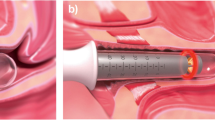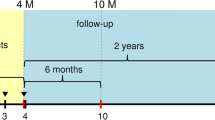Abstract
Purpose
To evaluate the effectiveness of vaginal Er:YAG laser as treatment in patients with mild or moderate stress urinary incontinence.
Methods
The study was a prospective, non-randomised, single center study of 33 women treated with two Er:YAG laser applications on an interval of four weeks. Follow-up evaluations were performed 4 and 8 weeks and 6 months after the first vaginal Er:YAG laser application (4 weeks and 5 months after the second vaginal Er:YAG laser application, respectively). The subjective outcomes were assessed using the International Consultation of Incontinence Modular Questionnaire Short Form (ICIQ-SF) and medical history. Patients rated their quality of life on a scale from 0 to 10.
Results
The average quality of life (QoL) showed a significant improvement 5 months after both Er:YAG laser applications. The mean QoL score was 6.0 (SD 2.4) and improved to a mean of 7.6 (SD 1.8) (p = 0.004). The mean ICIQ-SF score changed significantly from 12.3 (SD 3.2, median 13, range 8-18) before treatment to 6.8 (SD 4.0, median 7, range 0–15) 6 months after treatment (p <0.001). 24 patients out of 32 (75%) would again choose to have this therapy performed and 25 patients of 32 (78%) would recommend the vaginal Er:YAG laser therapy to a friend. The rate of side effects was low and none of the patients needed a medical treatment.
Conclusions
This study confirms that vaginal Er:YAG therapy can improve clinical and quality of life outcomes in patients with SUI.



Similar content being viewed by others
References
Gold DM (2003) The pelvic floor. Pemberton JH, Swash M, HenryMM (eds) 250 × 200 mm. pp. 504. Illustrated (2002) WB Saunders: London. BJS 90:251–252
Rechberger T, Postawski K, Jakowicki JA, Gunja-Smith Z, Woessner JF Jr (1998) Role of fascial collagen in stress urinary incontinence. Am J Obstet Gynecol 179:1511–1514
Liapis A, Bakas P, Pafiti A, Frangos-Plemenos M, Arnoyannaki N, Creatsas G (2001) Changes of collagen type III in female patients with genuine stress incontinence and pelvic floor prolapse. Eur J Obstet Gynecol Reprod Biol 97:76–79
Vizintin Z, Lukac M, Kazic M, Tettamanti M (2015) Erbium laser in gynecology. Climacteric 18(Suppl 1):4–8. https://doi.org/10.3109/13697137.2015.1078668
Lapii GA, Yakovleva AY, Neimark AI (2017) Structural reorganization of the vaginal mucosa in stress urinary incontinence under conditions of Er:YAG laser treatment. Bull Exp Biol Med 162:510–514. https://doi.org/10.1007/s10517-017-3650-0
Schüssler B (1983) Zur Klassifikation der Stressinkontinenz nach Ingelman-Sundberg. Gynäkol Geburtshilfliche Rundsch 23:166–174
Gofrit ON, Landau EH, Shapiro A, Pode D (1998) The Stamey procedure for stress incontinence: long-term results. Eur Urol 34:339–343
Abrams P et al (2006) The international consultation on incontinence modular questionnaire: www.iciq.net. J Urol 175:1063–1066
Blaganje M et al (2018) Non-ablative Er:YAG laser therapy effect on stress urinary incontinence related to quality of life and sexual function: A randomized controlled trial. Eur J Obstet Gynecol Reprod Biol 224:153–158
Gambacciani M et al (2018) Long-term effects of vaginal erbium laser in the treatment of genitourinary syndrome of menopause. Climacteric 21:148–152
Ogrinc UB, Sencar S, Lenasi H (2015) Novel minimally invasive laser treatment of urinary incontinence in women. Lasers Surg Med 47:689–697
Tien YW et al (2017) Effects of laser procedure for female urodynamic stress incontinence on pad weight, urodynamics, and sexual function. Int Urogynecol J 28:469–476
Okui N (2019) Comparison between erbium-doped yttrium aluminum garnet laser therapy and sling procedures in the treatment of stress and mixed urinary incontinence. World J Urol 37:885–889
Author information
Authors and Affiliations
Contributions
CR: Protocol/ project development, data collection and management, data analysis, manuscript writing and editing. SH: Protocol development, data collection and management, data analysis, manuscript editing. BS: Protocol development, statistical analysis, manuscript editing. SYB: Data analysis, manuscript editing. FN: Project administration, supervision, data writing.
Corresponding author
Ethics declarations
Conflicts of interest
For the study Asclepion Laser Technologies GmbH Jena Germany provided us with the Juliet Laser and the single use handpiece adapters. Our research did not involve animals.
Informed consent
From all human participants Informed consent was obtained.
Additional information
Publisher's Note
Springer Nature remains neutral with regard to jurisdictional claims in published maps and institutional affiliations.
Rights and permissions
About this article
Cite this article
Reisenauer, C., Hartlieb, S., Schoenfisch, B. et al. Vaginal therapy of mild and moderate stress urinary incontinence using Er:YAG laser: a real treatment option. Arch Gynecol Obstet 300, 1645–1650 (2019). https://doi.org/10.1007/s00404-019-05334-2
Received:
Accepted:
Published:
Issue Date:
DOI: https://doi.org/10.1007/s00404-019-05334-2




